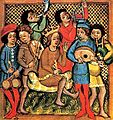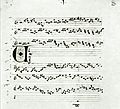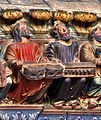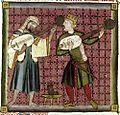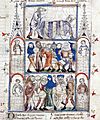Medieval music facts for kids
Medieval music is the kind of music that was made during the Middle Ages. This long period lasted from about 400 AD to 1400 AD. We don't know everything about music from this time. This is because it was so long ago, and music wasn't always written down. People used music for fun and for special events.
Contents
What Kinds of Medieval Music Were There?
Medieval music was made for many different reasons. This led to many different types of music. Music for church services was very important. But there was also music for everyday life, like love songs and dances.
In the early Middle Ages, church music usually had only one melody. This was called monophonic chant. Gregorian chant became the most common style. Later, music with many different melodies played at the same time started to appear. This is called polyphonic music. It became very popular by the 1200s and 1300s.
Early Polyphonic Music: Organum
One early type of polyphonic music was called Organum. This was when singers added one or more extra lines to a main chant melody. Sometimes, the extra line was simple. It would just follow the main melody at a set distance, like a perfect fifth or perfect fourth. This idea goes back to the 800s.
Many examples of organum come from the Notre-Dame school in Paris. This collection of music is often called the Magnus Liber Organi, which means "Great Book of Organum."
Motets and Madrigals
Other polyphonic types of music included the motet and clausula. These were also often built on a piece of Gregorian chant. At first, motets were for church services. But by the late 1200s, they also included everyday topics, like courtly love.
In Italy, a type of everyday song called the Madrigal became popular. Madrigals also had many melodies. They were often more flowing than motets. Madrigals also led to canons. These are songs where different singers sing the same melody but start at different times. In Italy, these were called caccie. They were three-part songs, often with two singers doing a canon and an instrument playing a long note underneath.
Instrumental Music
In the late Middle Ages, some music for instruments only also started to be written down. This was still rare. Most of the instrumental music that survived was for dancing. Examples include the estampie, ductia, and nota.
How Medieval Music Was Written Down
The earliest medieval music was not written down at all. The songs usually had only one melody. People learned them by listening and remembering.
The first way to write music used dots above the words of a song. Some dots were higher or lower, showing if the melody went up or down. But this only helped singers who already knew the tune. So, people needed a better way to write music.
The Musical Staff
The next step was "heighted neumes." Neumes were signs written above the words. They showed how the pitch moved. Lines were drawn in different colors. Red was often for F, and yellow or green for C. This was the start of the musical staff we use today.
Many people say that Guido of Arezzo (around 1000–1050) finished the four-line staff. Some experts now think he mostly helped organize a system that was already being developed. Either way, this new way of writing music helped singers learn new songs much faster.
Traveling Musicians: Troubadours and Trouvères
In Europe, there were people who traveled around. They earned a living by singing and playing musical instruments. They often visited the homes of rich people and entertained them. These traveling musicians were called minstrels in England. They were called troubadours or trouvères in other countries, and Minnesinger in Germany.
Minstrels often sang long songs that told stories. These were called ballads. This was a way to share news or tell made-up stories about love or mythology.
Richard the Lionheart, a king of England, loved music. He wrote many songs like the trouvères. A famous story says that when he was captured during a Crusade, his helper, Blondel, found him by hearing him sing a song they both knew. The song was called Ja Nuns Hons Pris ("I am no longer captive").
Minstrels often went with their masters to battles. They also sang at important events, like when someone became a knight. Many played instruments like the lute or fiddle.
Minstrels were both poets and musicians. They made up their own words and tunes. Sometimes, we know the words because they were written down. But the tunes were often not written down. Walther von der Vogelweide was a famous minnesinger in Germany.
One famous tune that was written down is the round Sumer is icumen in. A monk wrote it down. Monks could often read and write.
Troubadours traveled from town to town, often playing love songs.
Popular Medieval Dances
There were two main types of dances in medieval times: line dances and circle dances. The farandole was a line dance. It was a bit like a modern conga line, with people following a leader. The bransle was a round dance or circle dance. The word "bransle" comes from the French word "branler," meaning "to sway."
Other dances included the basse dance and estampie.
Musical Instruments of the Middle Ages
Instruments could be divided into two groups: quiet ones for indoors and loud ones for outdoors. The recorder was a very popular indoor instrument. People also played the psaltery and the harp. The harp looked like a small Welsh harp of today.
The bagpipes were loud instruments used outdoors, often for dancing. They were not as loud as modern Scottish bagpipes. They were more like Northumbrian pipes or French musettes. The hurdy-gurdy was played by turning a handle. Pipe and tabor were used for Morris dancing.
Many medieval string instruments were similar to the modern guitar. These included the lute and mandolin. The dulcimer and zither had strings that were hit with sticks. These are still popular in Eastern Europe today. There were also "fiddles" (vielle) and early forms of trombones, called sackbut.
People in the Middle Ages believed that listening to music while eating helped digest food and kept the heart healthy. They even thought it might keep you from getting fat! Dancing while eating was also thought to keep you fit.
Music in the Church
Church music was very important. The mass was the main type of church music. It used five main parts: Kyrie, Gloria, Credo, Sanctus, and Agnus Dei. Priests wanted church music to be serious. They didn't want it to be too popular, thinking people might forget about worshipping God.
Religious plays became very popular. They told stories from the Bible. However, church leaders sometimes banned them. So, these plays were performed in the streets and town squares instead.
Instruments were often not allowed in church at first. Church leaders thought they belonged to the devil. Only singing was allowed. But slowly, the organ started to be allowed in church. It helped people sing. Some organs were very small, called portative organs. Large, fixed organs were called "positives." Bells were also used in church. They looked like modern sleigh bells.
Medieval church music was based on plainsong. This was a melody that sounded free in rhythm. Composers started adding a second part to the melody. This was called organum. Sometimes, it just followed the main tune a fourth or fifth below. This was called "parallel organum." In the 1100s and 1200s, the original plainsong was often put at the bottom. It became known as the cantus firmus, meaning "firm tune."
Sometimes, antiphony was used. This is when a leader sings something, and a group (the choir) sings something back.
The main type of plainchant that developed was Gregorian chant. By the 1200s, almost all other types of chant in Western Europe were forgotten.
Carols and Wassailing
Carols became popular during this time. At first, a carol was a dancing song. But these popular songs often became used for specific seasons or festivals. Later, these developed into the Christmas carols we know today.
People often went around in groups, especially at Christmas. They would sing at the houses of rich people. This was called Wassailing. The word means "being of good cheer," or "happy." The Boar’s Head is a well-known medieval carol.
Mummers were groups of traveling entertainers. They performed religious plays. They usually wore masks so people wouldn't know who they were.
Music from the High Middle Ages (1150-1300)
Most of the medieval music we know today comes from the later part of the Middle Ages. There was a special tradition called the "Notre Dame school." This music was made around 1150 to 1250. This was when huge cathedrals were being built in the Gothic style, like Notre Dame Cathedral.
The music from this time was called "Ars antiqua" ("Old art"). It used a system of rhythms called "rhythmic modes." Slowly, a new way of writing music developed. This was called "Ars nova" ("New art"). The most famous composer of this time was Guillaume de Machaut. He created a type of music called the isorhythmic motet. He also wrote many songs called chansons (the French word for "song"). Other types of songs were called rondeau, ballade, and virelai.
Composers born at the very end of the Middle Ages, like John Dunstaple, Guillaume Dufay, and Gilles Binchois, are often considered part of the next period in music history: the Renaissance period.
Images for kids
-
A musician plays the vielle in a fourteenth-century medieval manuscript
-
Pérotin's Viderunt omnes, ca. 13th century.
-
Musicians playing the Spanish vihuela, one with a bow, the other plucked by hand, in the Cantigas de Santa Maria of Alfonso X of Castile, 13th century
-
Men playing the organistrum, from the Ourense Cathedral, Spain, 12th century
-
Christian and Muslim playing lutes in a miniature from Cantigas de Santa Maria of Alfonso X
-
The chanson Belle, bonne, sage by Baude Cordier, an Ars subtilior piece included in the Chantilly Codex
-
Manuscript of the Mass Missa O Crux Lignum by Antoine Busnois (ca. 1450).
See also
 In Spanish: Música de la Edad Media para niños
In Spanish: Música de la Edad Media para niños


